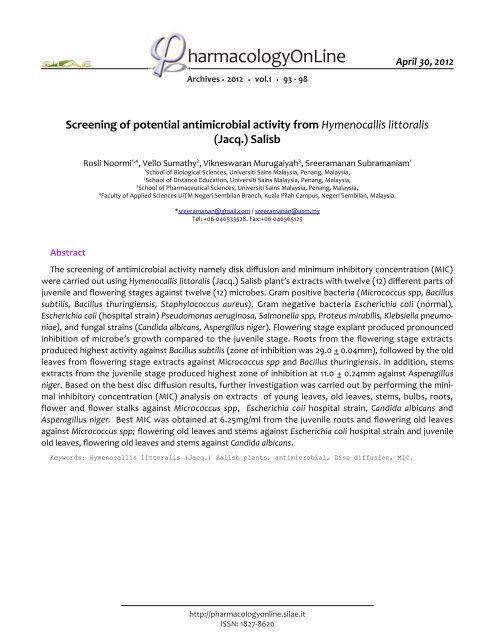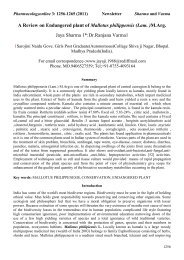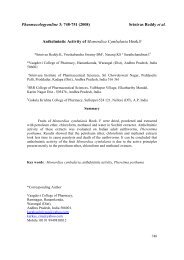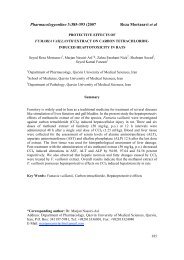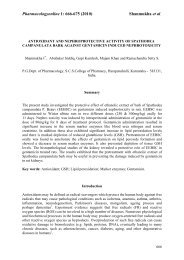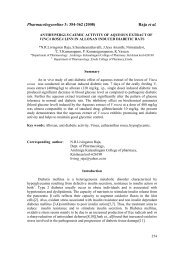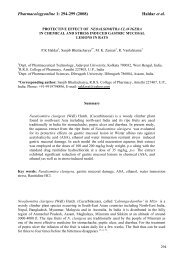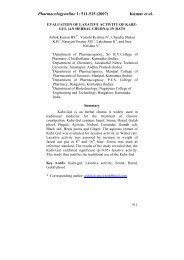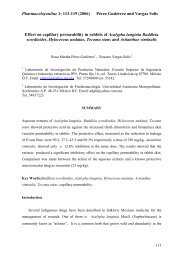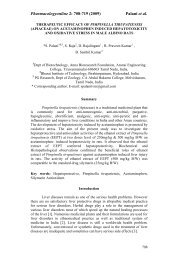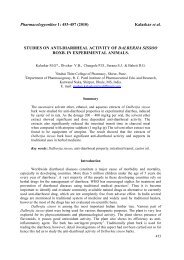Screening of potential antimicrobial activity from Hymenocallis littoralis
Screening of potential antimicrobial activity from Hymenocallis littoralis
Screening of potential antimicrobial activity from Hymenocallis littoralis
You also want an ePaper? Increase the reach of your titles
YUMPU automatically turns print PDFs into web optimized ePapers that Google loves.
harmacologyOnLine<br />
Archives • 2012 • vol.1 • 93 - 98<br />
http://pharmacologyonline.silae.it<br />
ISSN: 1827-8620<br />
April 30, 2012<br />
<strong>Screening</strong> <strong>of</strong> <strong>potential</strong> <strong>antimicrobial</strong> <strong>activity</strong> <strong>from</strong> <strong>Hymenocallis</strong> <strong>littoralis</strong><br />
(Jacq.) Salisb<br />
Abstract<br />
Rosli Noormi 1,4 , Vello Sumathy 2 , Vikneswaran Murugaiyah 3 , Sreeramanan Subramaniam 1<br />
1 School <strong>of</strong> Biological Sciences, Universiti Sains Malaysia, Penang, Malaysia,<br />
2 School <strong>of</strong> Distance Education, Universiti Sains Malaysia, Penang, Malaysia,<br />
3 School <strong>of</strong> Pharmaceutical Sciences, Universiti Sains Malaysia, Penang, Malaysia,<br />
4 Faculty <strong>of</strong> Applied Sciences UiTM Negeri Sembilan Branch, Kuala Pilah Campus, Negeri Sembilan, Malaysia.<br />
*sreeramanan@gmail.com / sreeramanan@usm.my<br />
Tel: +06-046533528. Fax:+06-046565125<br />
The screening <strong>of</strong> <strong>antimicrobial</strong> <strong>activity</strong> namely disk diffusion and minimum inhibitory concentration (MIC)<br />
were carried out using <strong>Hymenocallis</strong> <strong>littoralis</strong> (Jacq.) Salisb plant’s extracts with twelve (12) different parts <strong>of</strong><br />
juvenile and flowering stages against twelve (12) microbes. Gram positive bacteria ( Micrococcus spp, Bacillus<br />
subtilis, Bacillus thuringiensis, Staphylococcus aureus), Gram negative bacteria Escherichia coli (normal),<br />
Escherichia coli (hospital strain) Pseudomonas aeruginosa, Salmonella spp, Proteus mirabilis, Klebsiella pneumoniae),<br />
and fungal strains (Candida albicans, Aspergillus niger). Flowering stage explant produced pronounced<br />
inhibition <strong>of</strong> microbe’s growth compared to the juvenile stage. Roots <strong>from</strong> the flowering stage extracts<br />
produced highest <strong>activity</strong> against Bacillus subtilis (zone <strong>of</strong> inhibition was 29.0 + 0.04mm), followed by the old<br />
leaves <strong>from</strong> flowering stage extracts against Micrococcus spp and Bacillus thuringiensis. In addition, stems<br />
extracts <strong>from</strong> the juvenile stage produced highest zone <strong>of</strong> inhibition at 11.0 + 0.24mm against Asperagillus<br />
niger. Based on the best disc diffusion results, further investigation was carried out by performing the minimal<br />
inhibitory concentration (MIC) analysis on extracts <strong>of</strong> young leaves, old leaves, stems, bulbs, roots,<br />
flower and flower stalks against Micrococcus spp, Escherichia coli hospital strain, Candida albicans and<br />
Asperagillus niger. Best MIC was obtained at 6.25mg/ml <strong>from</strong> the juvenile roots and flowering old leaves<br />
against Micrococcus spp; flowering old leaves and stems against Escherichia coli hospital strain and juvenile<br />
old leaves, flowering old leaves and stems against Candida albicans.<br />
Keywords: <strong>Hymenocallis</strong> <strong>littoralis</strong> (Jacq.) Salisb plants, <strong>antimicrobial</strong>, Disc diffusion, MIC.
PhOL<br />
Introduction<br />
Opportunistic diseases in the globalization <strong>of</strong> the<br />
world contributed huge number <strong>of</strong> increasing the<br />
survival rate <strong>of</strong> patients. The prime agent that leads<br />
to these diseases is pathogenic microorganisms 19. .<br />
Several diseases have been treated by the admini-<br />
9 and<br />
stration <strong>of</strong> plant extracts <strong>from</strong> medicinal plants.<br />
15. Therefore, many efforts have been made to<br />
discover new <strong>antimicrobial</strong> compounds <strong>from</strong><br />
various kinds <strong>of</strong> sources such as micro-organisms,<br />
animals, and plants 9. . For example, extracts <strong>of</strong><br />
Garcinia kola seeds can <strong>potential</strong>ly be useful in the<br />
treatment <strong>of</strong> staphylococcal wound infections 18 .<br />
The traditional uses <strong>of</strong> medicinal plants in healthcare<br />
practices are providing clues to new areas <strong>of</strong><br />
research and hence its importance is now well<br />
recognized 11. . <strong>Hymenocallis</strong> <strong>littoralis</strong> (Jacq.) Salisb<br />
commonly known as ‘Spider Lily’ is a bulbous,<br />
herbaceous plant <strong>from</strong> the family <strong>of</strong><br />
Amaryllidaceae14. . The plant is distributed by the<br />
sea and in swamps in tropical, sub-tropical, and<br />
10.<br />
temperate regions throughout the world .<br />
Throughout the history <strong>of</strong> <strong>Hymenocallis</strong> <strong>littoralis</strong>,<br />
several alkaloids had been discovered <strong>from</strong> its bulb.<br />
The first alkaloid lycorine was proven to have<br />
1, 12<br />
antineoplastic, cytotoxic and antiviral properties<br />
and 16 .<br />
The present investigation was made to evaluate<br />
the <strong>antimicrobial</strong> <strong>activity</strong> <strong>of</strong> <strong>Hymenocallis</strong> <strong>littoralis</strong><br />
(Jacq.) Salisb wild plant explants. The objectives <strong>of</strong><br />
present study are to determine the disc diffusion<br />
and minimum inhibition concentration (MIC) <strong>of</strong><br />
<strong>Hymenocallis</strong> <strong>littoralis</strong> wild (Jacq.) Salisb plant<br />
extracts.<br />
Materials and Methods<br />
Plant Source<br />
<strong>Hymenocallis</strong> <strong>littoralis</strong> (Jacq.) Salisb plants used in<br />
this study (Figure 1) were obtained <strong>from</strong> Penang<br />
Botanical Gardens, Malaysia. The plants were cut<br />
into their part namely young leaf, old leaf, stem,<br />
bulb and root for juvenile stage; and young leaf, old<br />
http://pharmacologyonline.silae.it<br />
ISSN: 1827-8620<br />
94 (93 - 98)<br />
leaf, stem, bulb, root, flower and flower stalk for<br />
flowering stage. Plant materials were washed with<br />
distilled water and dried in an oven at 35-40 o C for 7<br />
days.<br />
Plant Extract Preparation<br />
Two (2) stages <strong>of</strong> <strong>of</strong> <strong>Hymenocallis</strong> <strong>littoralis</strong> (Jacq.)<br />
Salisb <strong>of</strong> juvenile and flowering were collected,<br />
dissected, and washed with clean sterile water.<br />
Then, the explants were surface sterilized with 10%<br />
Sodium Hypochlorite solution and rinsed with<br />
sterile distilled water before dried in an oven at<br />
45 o C for 48 hours. Finally, explants was ground<br />
using mortar and pestle into fine powder sample.<br />
Chlor<strong>of</strong>orm and Methanol Extractions<br />
The extraction procedure used in this study was<br />
modified <strong>from</strong> the procedure <strong>of</strong> alkaloid extraction 6,<br />
7 and 13. . One (1) gram <strong>of</strong> dried samples was ground<br />
using pestle and mortar, before adding 20 ml <strong>of</strong><br />
solvent 3:1 (CHCl 3 : MeOH). The extracts were then<br />
sonicated by using analog ultrasonic cleaner (WUC-<br />
A02H WiseClean Ultrasonic Cleaner, DAIHAN<br />
Sciencetific Co., Ltd. Sungbuk-Gu, Korea) for 15<br />
minutes. The homogenate was filtered through four<br />
layers <strong>of</strong> miracloth and centrifuged at 12 000 X g for<br />
10 min at 4 o C.<br />
Test Solution and Disk Preparation<br />
Test solution was prepared with known weight <strong>of</strong><br />
crude extracts, and dissolved in 5% dimethyl sulphoxide<br />
(DMSO). Whatman No. 1 sterile filter paper<br />
discs (6 mm) were impregnated with 20µl <strong>of</strong> this<br />
extract (corresponding to 100 mg/ml <strong>of</strong> crude plant<br />
extract) and allowed to dry at room temperature.<br />
Microorganisms<br />
Ten (10) bacteria strains used were Gram positive<br />
bacteria, namely Micrococcus spp, Bacillus subtilis,<br />
Bacillus thuringiensis and Staphylococcus aureus; and
PhOL<br />
Gram negative bacteria namely Escherichia coli<br />
(hospital strain) , Pseudomonas aeruginosa,<br />
Pseudomonas aeruginosa, Pseudomonas aeruginosa,<br />
Salmonella spp, Proteus mirabilis and Klebsiella<br />
pneumoniae. Two (2) fungal pathogens used were<br />
Candida albicans and Aspergillus niger. These standard<br />
strains were obtained <strong>from</strong> the Microbiology<br />
Laboratory stock, School <strong>of</strong> Biological Sciences,<br />
Universiti Sains Malaysia. All bacteria were maintained<br />
on Nutrient Agar (NA) at 37ºC and fungi on<br />
Potato Dextrose Agar (PDA) at 28 ºC.<br />
Determination <strong>of</strong> Minimum inhibitory concentration<br />
(MIC)<br />
Minimum inhibitory concentration (MIC) was<br />
determined using the broth dilution method 4. The<br />
crude <strong>Hymenocallis</strong> <strong>littoralis</strong> (Jacq.) Salisb extract<br />
was dissolved in methanol to obtain the initial<br />
concentration as 100 mg/ml. Two-fold dilution was<br />
performed <strong>from</strong> the initial test concentration and<br />
each tube was inoculated with 500 ìl suspension<br />
containing 108 CFU/ml <strong>of</strong> bacteria and 104 spore/ml<br />
<strong>of</strong> fungi. The test tube for bacteria was incubated at<br />
37 ºC for 24 hours and at 28 ºC for 48 hours for<br />
fungi. MIC was determined as the lowest concentration<br />
<strong>of</strong> the extract inhibiting the visual growth <strong>of</strong><br />
the test cultures in the tubes based on turbidity.<br />
Results and Discussion<br />
Twelve (12) samples crude extracts <strong>of</strong> different<br />
explants <strong>from</strong> juvenile and flowering stages <strong>from</strong><br />
<strong>Hymenocallis</strong> <strong>littoralis</strong> (Jacq.) Salisb wild plant were<br />
used to screen the <strong>antimicrobial</strong> <strong>activity</strong> namely the<br />
juvenile stage; young leaf, old leaf, stem, bulb and<br />
root and flowering stage; young leaf, old leaf, stem,<br />
bulb, root, flower and flower stalk (Table 1).<br />
Meanwhile, twelve (12) microbes (Table 1) were<br />
used to test all the samples, namely Gram positive<br />
bacteria ( Micrococcus spp, Bacillus subtilis, Bacillus<br />
thuringiensis, Staphylococcus aureus), Gram negative<br />
bacteria (Escherichia coli [normal]), Escherichia coli<br />
(hospital strain) Pseudomonas aeruginosa,<br />
Salmonella spp, Proteus mirabilis, Klebsiella pneumo-<br />
http://pharmacologyonline.silae.it<br />
ISSN: 1827-8620<br />
95 (93 - 98)<br />
niae, and fungal strains ( Candida albicans and<br />
Asperagillus niger).<br />
Overall, flowering stage explants showed pronounced<br />
inhibition <strong>of</strong> microbe’s growth <strong>of</strong> the<br />
cultures compared to the juvenile stage with<br />
different range on inhibiton zone (Table 1). Most<br />
probably, the highest amount <strong>of</strong> secondary metabolite<br />
was presented such as an alkaloid in mature<br />
plant was the main reason for these results obtained.<br />
These results were supported in the statement<br />
by Borek 4. that the mature fruits were the<br />
richest organs for daidzein concentration in Porzana<br />
cinerea. In other hand, Godjevac (2004) 8 and<br />
Slavica (2004)19 were reported the present <strong>of</strong><br />
flavonoids <strong>from</strong> flower <strong>of</strong> their selected research<br />
plants.<br />
Stems extracts <strong>from</strong> the juvenile stage against<br />
Aspergillus niger produced highest zone <strong>of</strong> inhibition<br />
at 11.0 + 0.24mm. In addition, roots <strong>from</strong> the<br />
flowering stage extracts produced highest <strong>activity</strong><br />
against Bacillus subtilis (zone <strong>of</strong> inhibition was 29.0<br />
+ 0.04mm), followed by the old leaves <strong>from</strong> flowering<br />
stage extracts against Micrococcus spp and<br />
Bacillus thuringiensis. The highest zone <strong>of</strong> inhibition<br />
<strong>from</strong> this investigation was contrast different with<br />
the disc diffusion results <strong>from</strong>20. the extraction <strong>of</strong><br />
the flower <strong>of</strong> Musa acuminata whereas the highest<br />
zone <strong>of</strong> inhibition <strong>from</strong> their study was 22mm<br />
against Staphylococcus aureus and the lowest zone<br />
inhibiton was 12mm against Escherichia coli.<br />
Meanwhile, similar result <strong>of</strong> the highest disc diffusion<br />
was reported that leaves extracts <strong>of</strong> Euphorbia<br />
hirta against Micrococcus sp. and the lowest zone <strong>of</strong><br />
inhibition was 9 mm <strong>from</strong> the flower plant extract<br />
against Proteous mirabilis 2 . The zone <strong>of</strong> inhibition<br />
for negative control (methanol) was zero.<br />
However, larger clear zones were observed on the<br />
plates with 30μg/ml <strong>of</strong> kanamycin tested on<br />
Micrococcus spp and 30μg/ml penicillin (antibiotics)<br />
tested on Bacillus compared to the methanol crude<br />
extract (Table 1).<br />
Minimal inhibitory concentrations (MIC) was<br />
carried out on selected extracts <strong>from</strong> young leaves,<br />
old leaves, stems, bulbs, roots, flower and flower
PhOL<br />
stalks against selected microbes, namely the<br />
Micrococcus spp, Escherichia coli hospital strain,<br />
Candida albicans and Aspergillus niger. Best MIC was<br />
obtained at 6.25mg/ml <strong>from</strong> the juvenile roots and<br />
flowering old leaves against Micrococcus spp;<br />
flowering old leaves and stems against Escherichia<br />
coli hospital strain; and juvenile old leaves, flowering<br />
old leaves and stems against Candida albicans<br />
(Table 2). This was significantly different with the<br />
MIC results obtained by other researchers 2, 20.<br />
Meanwhile, the best MIC value was at 1.56 mg/ml<br />
tested on Musa acuminata extract against<br />
Staphylococcus aureus 20. In addition, the best MIC<br />
value was reported about 3.13 mg/ml extracts <strong>of</strong><br />
Euphorbia hirta against Escherichia coli and Candida<br />
albicans 2.<br />
The significant <strong>antimicrobial</strong> <strong>activity</strong> <strong>from</strong> disc<br />
diffusion and MIC shown by these extracts suggested<br />
that <strong>Hymenocallis</strong> <strong>littoralis</strong> (Jacq.) Salisb could<br />
be a <strong>potential</strong> remedy against infections caused by<br />
Candida albicans and Escherichia coli hospital strains.<br />
Conclusion<br />
Overall, flowering stage explants showed pronounced<br />
inhibition <strong>of</strong> microbe’s growth compared<br />
to the juvenile stage. Roots <strong>from</strong> the flowering<br />
stage extracts produced highest <strong>activity</strong> against<br />
Bacillus subtilis, followed by the old leaves <strong>from</strong><br />
flowering stage extracts against Micrococcus spp<br />
and Bacillus thuringiensis. In addition, stems extracts<br />
<strong>from</strong> the juvenile stage against Aspergillus niger<br />
produced highest zone <strong>of</strong> inhibition. Best MIC was<br />
obtained at 6.25mg/ml <strong>from</strong> the juvenile roots and<br />
flowering old leaves against Micrococcus spp;<br />
flowering old leaves and stems against Escherichia<br />
coli hospital strain; and juvenile old leaves, flowering<br />
old leaves and stems against Candida albicans.<br />
References<br />
1. Abou-Donia AH, Toaima SM, Hammoda HM, Kinoshita E &<br />
Takayama H. Pytochemical and biological investigation <strong>of</strong><br />
<strong>Hymenocallis</strong> <strong>littoralis</strong> SALISB. Chem Biodivers. 2008;<br />
5(2):332-40.<br />
2. Basma Rajeh M A, Zuraini Z, Sasidharan S, Yoga Latha L and<br />
http://pharmacologyonline.silae.it<br />
ISSN: 1827-8620<br />
96 (93 - 98)<br />
Amutha S. Assessment <strong>of</strong> Euphorbia hirta L. Leaf, flower,<br />
stem and root extracts for their antibacterial and antifungal<br />
<strong>activity</strong> and brine shrimp lethality. J Mol. 2010; (15):6008-<br />
6018.<br />
3. Borek B. Antioxidants and cancer. Science Medical (Phila).<br />
1997; 4: 51-62.<br />
4. Bouque V, Bourgaud F and Guckert A. Production <strong>of</strong><br />
daidzein by callus cultures <strong>of</strong> Psoralea spesies and<br />
comparison with plants. Plant Cell Tissue Org. 1998; 53(1):35-<br />
40.<br />
5. Chandrasekaran M and Venkatesalu V. Antibacterial and<br />
antifungal <strong>activity</strong> <strong>of</strong> Syzygium jambolanum seeds. J<br />
Ethnopharmacol. 2004; 91:105-108.<br />
6. Choo, C.Y., Chan, K.L., Marziah, M. and Kandasamy, K.L.<br />
Comparative studies <strong>of</strong> the chemical constituents <strong>of</strong> the leaf,<br />
root, callus and somatic embryos <strong>of</strong> Eurycoma longifolia<br />
(Tongkat Ali). In Proceeding ‘Second Malaysia-<br />
Massachusetts Institude Of Technology Biotechnology<br />
Partnership (MMBPP) Symposium’, MPOB HQ, Bangi 2001;<br />
Pg 5-6.<br />
7. Choo CY, Chan KL High performance liquid chromatography<br />
analysis <strong>of</strong> canthinone alkaloids <strong>from</strong> Eurycoma longifolia.<br />
Planta Med. 2002; 68:382-384.<br />
8. Godjevac D, Vajs V, Menkovic N, Tesevic V, Janackovic P and<br />
Milosavljevic. Flavonoids <strong>from</strong> flowers <strong>of</strong> Cephalaria<br />
pastricensis and their antiradical <strong>activity</strong>. J. Serb. Chem. Soc.<br />
2004; 69(11):883-886.<br />
9. Janovska D, Kubikova K and Kokoska L. <strong>Screening</strong> for<br />
<strong>antimicrobial</strong> <strong>activity</strong> <strong>of</strong> some medicinal plants spesies <strong>of</strong><br />
traditional Chinese medicine. Czech J. Food Science. 2003;<br />
21(3):107-110.<br />
10. Ji Z & Meerow AW. Amaryllidaceae. Flora <strong>of</strong> China. 1985;<br />
24:264.<br />
11. Lal B and Farrukh H. People preferences and use <strong>of</strong> local<br />
medicinal flora in District Tank, Pakistan. J Med Plants Res.<br />
2011; 5(1):22-29.<br />
12. Lin LZ, Hu SF, Chai HB, Pengsuparp T, Pezzuto JM, Cordell<br />
GA & Ruangrungsi N. Lycorine Alkaloids From <strong>Hymenocallis</strong><br />
<strong>littoralis</strong>. Phytochem. 1995; 40(4): 1295-8.<br />
13. Maziah M, Rosli N and Sreeramanan S. Distribution <strong>of</strong> 9methoxycanthin-6-0ne<br />
<strong>from</strong> the intact plant parts and callus<br />
cultures <strong>of</strong> Eurycoma longifolia (Tongkat Ali). Aust. J. Crop<br />
Sci. 2011; 5(12):1565-1569.<br />
14. Rafael Ocampo and Michael J. Plants <strong>of</strong> Semillas Sagradas:<br />
An Ethnomedical Garden in Costa Rica. Rev Cubana Plant<br />
Med v. 2009; 4(3):61-62.<br />
15. Raj Kumar Salar and Anjali Dhall. Antimicrobial and free<br />
radical scavenging <strong>activity</strong> <strong>of</strong> extracts <strong>of</strong> some Indian<br />
medicinal plants. J Med Plants Res. 2010; 4(22):2313-2320.<br />
16. Renard-Noiaki JT, Kim Y, Imakura M, Kihara and Kobayashi<br />
S. Effect <strong>of</strong> alkaloids isolated <strong>from</strong> Amaryllidaceae on<br />
Herpes-Simplex virus. Res Virol. 1989; 140: 115–128.<br />
17. Rosli N, Maziah M, Chan KL and Sreeramanan S. Factors<br />
affecting the accumulation <strong>of</strong> 9-methoxycanthin-6-one in<br />
callus cultures <strong>of</strong> Eurycoma longifolia. J. Forest Res. 2009;<br />
20(1): 54-58.<br />
18. Sibanda T, Olaniran A O and Okoh A I. In vitro antibacterial<br />
activities <strong>of</strong> crude extracts <strong>of</strong> Garcinia kola seeds against<br />
wound sepsis associated Staphylococcus strains. J. Med<br />
Plants Res. 2010; 4(8):710-716.<br />
19. Slavica B. I, Sandra S K and Zoran B T. Flavonoids <strong>from</strong><br />
flower <strong>of</strong> Linum capitatum kit. Phys Chem. Technol. 2004;<br />
3(1):67-71.<br />
20. Sumathy V, Jothy S Lachumy, Zuraini Zakaria and S<br />
Sasidharan . In vitro bio<strong>activity</strong> and phytochemical screening<br />
<strong>of</strong> Musa acuminata flower. Pharmacologyonline. 2011; 2:118-<br />
127.
PhOL<br />
Microorganisms Zone <strong>of</strong> Inhibition <strong>of</strong> disc diffusion (mm)<br />
(Antibiotic)<br />
Extracts<br />
1a 2a 3a 4a 5a 1b 2b 3b 4b 5b 6b 7b<br />
–——————–——————–——————–——————–——————–———————-————–—<br />
Micrococcus spp 25 24 24.3 24.3 25 27 28 24 26 24 25 26.3<br />
(Penicillin) (38.3) (35) (23) (41.3) (24) (20) (45.3) (45) (39) (32) (32) (33)<br />
Escherichia coli(normal) 21 24 24.3 24 20 23 23.3 23 21 19 23 24<br />
(Kanamycin) (22) (24) (22) (33) (24) (20) (35.7) (19) (19) (21) (20) (20)<br />
Escherichia coli(hospital) 21.3 20 20 22 21 21.3 24 24 22 23 24 20<br />
(Kanamycin) (22) (23) (24) (23) (23) (20) (19) (17) (20) (20) (18) (15)<br />
Bacillus subtilis 19 20 19 21.3 24 20 21 20 26 19 20 22<br />
(Penicillin) (22) (22) (23) (23) (23.3) (18) (17) (19) (19) (18) (14) (15)<br />
Pseudomonas aeruginosa 13 20 23 22 17 15 21 21 21 18 21 21<br />
(Kanamycin) (22) (22) (25) (25) (25) (23) (16) (20.7) (25) (22) (21) (21)<br />
Salmonella spp 21 23 20 28 23.3 25 23 24 24 26 22 23<br />
(Kanamycin) (22) (22) (25) (24) (24.3)(20) (18) (20) (20)(20)(22) (21)<br />
Bacillus thuringiensis 23 23 21 27 27 26 23 22 27 29 27 23<br />
(Penicillin) (33.3) (35) (23) (35) (35) (20) (28) (30) (33) (28) (22) (25)<br />
Proteus mirabilis 20 23.3 25 23 24 22.3 23 24 24.3 22 24 25<br />
(Kanamycin) (23) (24.5) (26) (25) (23) (19) (25) (20) (18) (19) (21) (25)<br />
Staphylococcus aureus 20 21 21 22 23 22 23 20 19 20 23 19<br />
(Vancomycin) (23) (25) (25) (23.3) (27) (15) (21) (21) (24) (21) (17) (24)<br />
Klebsiella pneumonia 24 20 23 22 24.3 20 24.3 23 22.3 24 26.3 24<br />
(Kanamycin) (23.5) (23) (24) (23.3) (23.3) (18.7) (18) (20) (20) (19) (24) (24)<br />
Candida albicans 24 24 23 27 26 22 23 24 27 25 22 23<br />
(Mecanazole nitrate) (23) (20) (24) (23) (27) (15) (22.7) (20) (18.3) (22) (18) (19)<br />
Aspergillus niger 15 13 11 17 17 12 15 19 20 19 23 23<br />
(Amphotericin) (23) (23.5) (23) (23.5) (26.3) (21) (22) (20) (19.3) (20) (22) (20)<br />
http://pharmacologyonline.silae.it<br />
ISSN: 1827-8620<br />
97 (93 - 98)<br />
Table 1: Antimicrobial <strong>activity</strong> by using disk diffusion technique. The values (average <strong>of</strong> triplicate) are diameter <strong>of</strong> zone <strong>of</strong> inhibition at 100mg/ml<br />
crude extract <strong>of</strong> <strong>Hymenocallis</strong> <strong>littoralis</strong> (Jacq.) Salisb, 30 ìg/ml each <strong>of</strong> antibiotic tested.
PhOL<br />
http://pharmacologyonline.silae.it<br />
ISSN: 1827-8620<br />
98 (93 - 98)<br />
Microorganisms MIC (mg/ml)<br />
Extract<br />
1a 2a 3a 4a 5a 1b 2b 3b 4b 5b 6b 7b<br />
–—————–—————–—————–—————–—————–—————–———————<br />
Micrococcus spp 12.5 - - - 6.25 - 6.25 - - - - -<br />
Escherichia coli(normal) - - - - - - - - - - - -<br />
Escherichia coli(hospital) - - - - - - 6.25 6.25 - - - -<br />
Bacillus subtilis - - - - - - - - - - - -<br />
Pseudomonas aeruginosa - - - - - - - - - - - -<br />
Salmonella spp - - - 12.5 - - - - - - - -<br />
Bacillus thuringiensis - - - 12.5 12.5 - - - - - - -<br />
Proteus mirabilis - - 100 - - - - - - - - -<br />
Staphylococcus aureus - - - - - - - - - - - -<br />
Klebsiella pneumonia - - - - - - - - - - - -<br />
Candida albicans 12.5 6.25 12.5 12.5 25 12.5 6.25 6.25 12.5 25 12.5 12.5<br />
Aspergillus niger - - - - - 50 12.5 12.5 50 25 50 12.5<br />
Table 2: Antimicrobial <strong>activity</strong> <strong>of</strong> minimum inhibitory concentration (MIC) by using broth dilution method. The values are in mg/ml<br />
<strong>of</strong> crude extract <strong>of</strong> <strong>Hymenocallis</strong> <strong>littoralis</strong> (Jacq.) Salisb.<br />
Figure 1: <strong>Hymenocallis</strong> <strong>littoralis</strong> (Jacq.) Salisb plant


